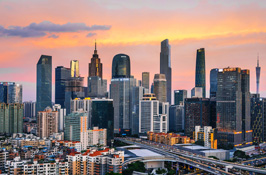Building bridges and making connections
Bay Area strengthens transport links among its cities and further afield
The Shenzhen-Zhongshan Link officially opened on June 30 as a major national project in the Guangdong-Hong Kong-Macao Greater Bay Area.
The bridge-island-tunnel project in South China's Guangdong province spans about 24 kilometers, and is located approximately 30 km south of Humen Bridge and some 31 km north of the Hong Kong-Zhuhai-Macao Bridge. It has an eight-lane dual carriageway, with a speed limit of 100 km per hour.
Serving as a crucial part of the transportation network around the Pearl River estuary, the passage connects two major urban clusters on the east and west banks of the river.
It also shortens the driving time between Shenzhen on the river's east bank and Zhongshan on the west bank to within 30 minutes, and brings more cities like Foshan, Zhuhai and Jiangmen into the one-hour economic circle around Shenzhen.
"Guangdong will enhance service efficiency of its road network and further improve the highways along the Shenzhen-Zhongshan Link and its neighboring areas, in a bid to provide efficient and safe support for the development of the Greater Bay Area," said Lin Feiming, head of the Guangdong Department of Transport.
The project showcases advanced infrastructure construction in China and is a vivid example of the country developing into a strong transportation nation, Lin noted.
It strings the urban clusters of the Bay Area together with Humen Bridge, Nansha Bridge, the Guangzhou-Shenzhen Expressway and the Guangzhou-Zhuhai east and west expressways, which can boost the interconnection of people, goods, capital and information across the Pearl River.
The rail transit network has also played a role in shortening the journey time between cities in the Bay Area.
On May 26, the Guangzhou-Foshan south ring and Foshan-Dongguan intercity railway opened for operation, connecting with the Foshan-Zhaoqing and Dongguan-Huizhou intercity lines.
Together they form a 258-km railway corridor that serves as an east-west artery in the Bay Area, featuring 39 stations across five cities. The trains can run at a maximum speed of 200 km/h.
By the end of 2023, the Bay Area had about 60,000 km of road mileage, including more than 4,500 km of expressway mileage. It has at least five expressway connections to each of the Guangxi Zhuang autonomous region, and Hunan, Jiangxi and Fujian provinces.
The railway operating mileage in the Bay Area exceeded 2,700 km as of 2023 and the urban rail transit operating mileage reached 1,373 km, both ranking among the highest in the country.
Moreover, the Bay Area has been accelerating the construction of world-class port and airport clusters. In 2023, the total annual cargo throughput at six such ports reached more than 100 million metric tons. By 2025, the annual cargo throughput of all ports in the Bay Area is expected to reach 2.1 billion tons.
The international shipping network, centered on the Guangzhou and Shenzhen ports, continues to improve in the Bay Area. It has opened about 450 international container liner routes, linking with more than 300 ports in more than 100 countries and regions worldwide.
In 2023, airports in nine major cities in the Pearl River Delta reached an annual passenger throughput capacity of more than 131 million, an increase of 147 percent over 2022.
Currently, the Bay Area has seven airports and the Guangzhou Baiyun Airport has ranked first in the country in passenger throughput for four consecutive years.
Promoting high-quality interconnectivity of transportation infrastructure is one of the key tasks to advance the economic development of the Bay Area, local officials said.
In the following years, Guangdong is to accelerate the construction of such projects as the Huangmao Sea Channel and Shiziyang Tunnel; better manage and utilize the Hong Kong-Zhuhai-Macao Bridge; and improve the main transport channels from the Bay Area to the eastern, western and northern regions of Guangdong.
The total mileage of expressways in the Bay Area is expected to reach 5,500 km by 2025 and 7,100 km by 2035.
In terms of railways, the province plans to pilot the integration of trunk railways, intercity lines, suburban railways and urban rail transit, forming a rail-linked circle of city clusters.
In addition, Guangdong will build world-class economically efficient, intelligent and environmentally friendly port and airport clusters with Hong Kong and Macao to sharpen the competitive edge of the clusters in the Bay Area.



 Print
Print Mail
Mail

